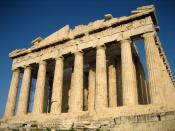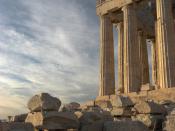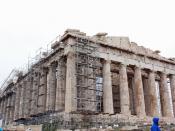Throughout history, there have been numerous factors that have influenced the development of western architecture. The most influential factor of classical architecture was humanism. The ideology of humanism is an attitude centered chiefly in the values, interests, and potential of human beings (Webster's II New Riverside Dictionary 205). Humanism is what leads to the development of the Classical World as we know it.
In the Classical World, that is ancient Greek and Rome, the ideology of humanism had a big impact in these civilizations. Humanism strongly influenced these civilizationÃÂs arts, and especially their architecture. For example, most ancient Greek buildings have been built to honor the Greek Pantheon, of gods and goddesses. One of the most important Greek buildings is the Parthenon, which was built between 447 and 438 BC. The Parthenon was designed by Phidias, and built by Ictinus on the Acropolis of Athens with the purpose to honor the goddess Athena and the people that honored her.
Also, the ParthenonÃÂs frieze and pediment are further evidence that prove the immense influence humanism had on Greek architecture. The ParthenonÃÂs frieze (a horizontal band that runs above the doorways or windows, and that can also be decorated with designs and carvings) is thought to represent the Panathenaic Procession ("Parthenon Frieze"). This was a festival that was celebrated on the 28th day of a month called Hekatombaion, and everyone in Athens, including non-residents and slaves (up to a point), was able to participate in numerous activities ranging from musical contests to athletic competitions where men would show off their abilities. This shows that humanism plays a role even in festivals celebrated in that time period. This holiday was believed to honor the goddess Athena as the city's patron divinity (ÃÂReligious LifeÃÂ). In addition, the ParthenonÃÂs east pediment describes the birth...


